What to know
- The conclave chose American-born Cardinal Robert Francis Prevost to be the next pope. He will be known as Pope Leo XIV.
- Leo is the first pope to have been born in the United States. He is also a citizen of Peru, where he has spent much of his life.
- He was elected leader of the world’s 1.4 billion Catholics on the second day of the conclave, by 133 red-robed cardinals who were sequestered in the Sistine Chapel.
'I swore in a good way': Catholic senators react to first American pope
Several of the Senate's two dozen Catholics spoke with NBC News about their elation that the new pope made history as the first American pontiff.
“Unfortunately, I swore in a good way that this is beeping good," Sen. Ruben Gallego said, adding that he would ask for forgiveness later.
Fellow Arizona Democrat Mark Kelly was also enthusiastic about the pope’s hailing from the United States, saying he is “incredibly excited ... as I think many Catholics across our country are.”
“Obviously, being from Chicago, I imagine he’s probably a Cubs fan, which doesn’t sit that well with me. But it’ll be OK,” Kelly said.
(According to the pope's brother, he's a White Sox fan.)
Sen. Susan Collins, R-Maine, said that she is “really excited about this” and that the pope’s nationality had come as a surprise.
“I don’t think anyone projected that the pope was going to be an American,” she said.
“It sounds like our new pope is going to continue the legacy of Pope Francis and be very inclusive, reach out to the poor and the privileged alike and share the message of God’s blessings on all of us and God’s unconditional love,” Collins added.
Sen. John Hoeven, R-N.D., said he has been telling people there would never be an American pope.
“If you’d have told me ahead of time, I’d say no way, never happened. This is phenomenal, Hoeven said.
Gallego suggested that Pope Leo XIV could "help increase recruitment" both to the Catholic Church and religion more broadly.
“Not just, obviously, Catholics, but I think it would potentially reinvigorate, you know, religious movements in this country. And I think there’s nothing wrong with that," he said.
What Cardinal Prevost had to say shortly before he became pope
In the days before he was elected pope, Prevost discussed his spiritual path and religious background in an interview on Italian TV. He talked about everything from growing up in Chicago to his hopes for the Catholic Church's future.
U.S. Conference of Catholic Bishops offers ‘prayers of thanksgiving’ for new pope
The president of the U.S. Conference of Catholic Bishops said today that bishops across the country “offer prayers of thanksgiving for the election of His Holiness Pope Leo XIV.”
“In my lifetime, the Church has been blessed with a series of popes each uniquely prepared for his particular moment in history yet sharing a common mission to proclaim the ageless truth of the Gospel,” the president of the conference, Archbishop Timothy P. Broglio, said in a statement.
He said that the conference rejoiced that the new pope is from the United States but that “he now belongs to all Catholics and to all people of good will.”
“His words advocating peace, unity, and missionary activity already indicate a path forward,” Broglio said.
Survivors Network of those Abused by Priests issues open letter to new pope
Before Leo's election, the Survivors Network of those Abused by Priests issued an urgent open letter to whoever would be the incoming pope “urging him to break with a history of complicity and cover-up and finally deliver justice to victims of rape and sexual abuse in the Catholic Church.”
“Many of the cardinals that elected you covered up the crimes committed against us, and the priests and others who assaulted us hold significantly greater social value and prestige than any of us, individually or collectively,” the network, widely known as SNAP, wrote in a lengthy letter.
“While the priest and other offenders may have stolen our bodies, it is the cardinals and bishops of the church, along with three successive popes before you, who have stolen our voices,” it continues.
Chicago Mass erupts on news of U.S. pope: 'Like a TD being scored'
Reporting from Chicago
The Rev. Gregory Sakowicz was presiding over noon Mass at Holy Name Cathedral in Chicago when someone whispered in his ear during communion that Robert Francis Prevost had been chosen as the next pope.
“I thought, ‘Wow. Unbelievable,’” Sakowicz said.
When he shared the news at the end of Mass, the crowd of around 175 showed their enthusiasm with applause. “They went crazy,” Sakowicz said.
“It was like a touchdown being scored. It just exploded,” he said.
White House says it has already heard from Leo's team
President Donald Trump told reporters this afternoon that he had received a call from the new pope’s team.
“They’ve already called. They have already spoken to us, and we’ll see what happens,” Trump said when he was asked whether he planned to meet the pope.
Vice President JD Vance also posted a congratulatory message on X about the pope's election this afternoon.
“Congratulations to Leo XIV, the first American Pope, on his election! I’m sure millions of American Catholics and other Christians will pray for his successful work leading the Church. May God bless him!” Vance wrote.
Indiana University students made mad dash through the streets for the big moment
Reporting from Vatican City
Three Indiana University students wrapped up their semester abroad with an experience they won’t soon forget: by joining the Vatican City crowd to see a new pope introduced.
The trio were released from class today and took off sprinting through the streets to get in place in time to learn that an American had been named leader of the Catholic Church.
“To be here, during this time … it’s a pretty cool experience,” one said.
Make no mistake, Leo is a White Sox fan, his brother says
It's the choice that everyone from Chicago has to make — White Sox or Cubs?
And being named pope doesn't get you out of it.
But Leo's brother said the decision was made long ago: Leo roots for the White Sox, John Prevost told NBC Chicago.
The Illinois man said that despite some media reports, his brother is a fan of the South Side team but that their parents had split loyalty between the Cubs and he St. Louis Cardinals.
And that news was something the White Sox could get behind.
"Family always knows best, and it sounds like Pope Leo XIV’s lifelong fandom falls a little closer to 35th and Shields, " the team told NBC Chicago. "Some things are bigger than baseball, but in this case, we’re glad to have a White Sox fan represented at the Vatican."
The team already has gear headed to the pope. "A pinstripe White Sox jersey with his name on it and a hat is already on the way to Rome, and of course, the Pontiff always is welcome at his ballpark," the White Sox said.
But the Cubs are good sports, too, congratulating Leo on social media and with a Wrigley Field sign —even if it did get his allegiance wrong.
A conclave decision that goes against conventional wisdom
Reporting from Vatican City
The decision to elect an American goes against conventional wisdom, which has held that the United States holds enough power in the world already.
The new pope has spent much of his life outside the United States, so he is also considered to have a global perspective, and in fact he holds a Peruvian passport in addition to his American and Vatican ones.
Notably, Leo addressed his flock in Spanish and Italian today after his election but not in his native English.
The new pope is getting right to work
Less than 24 hours after he was elected pope, Leo XIV will lead Mass.
Tomorrow at 11 a.m. local time (5 a.m. ET), Leo will celebrate Mass for the College of Cardinals in the Sistine Chapel. It will be broadcast live on Vatican media channels.
On Sunday, he will pray the Regina Coeli from the central balcony of St. Peter’s Basilica at noon local time (6 a.m. ET).
On Monday, at 10 a.m. local time (4 a.m. ET), he will meet in the Vatican with journalists.
Pope Leo is known as a fast texter among friends
Joseph Farrell, the vicar general of the order of St. Augustine, shared some fun facts about his friend, the former Cardinal Robert Prevost.
For one, the new pope is known as "the fastest on text," Farrell said, noting that his friend is always immediately answering his phone because he doesn't want to keep people waiting for replies.
He also loves tennis and usually plays once a week, Farrell said.
Farrell said he isn't sure why his friend chose "Leo" as his papal name, but he pointed out that Leo XIII was a supporter of social rights, particularly workers' rights.
Farrell had high praise for the new pope: He's “a good guy, the best."
Villanova University celebrates one of its own
“Not in my wildest dreams” did the president of Villanova University, the Rev. Peter Donohue, expect an alum to become pope, he said.
“I never expected it!” Donohue said on MSNBC hours after Leo was named the church's new leader.
“The entire Villanova nation is celebrating this,” and bells continue to ring on its Pennsylvania campus and have been doing so for hours, he said.
Donohue said the election of an American pope, and one who aligns closely with Pope Francis, signifies that the church is focused on progress.
“Our faith has to continue to move forward," he said, adding that the church needs “to ask forgiveness” for the mistakes it has made.
With a new pope in place and nightfall on its way, square begins to clear
Reporting from Vatican City
Shortly after the new pope left the balcony, thousands of people began filing out of the square as darkness began to descend.
Many stayed, chatting and celebrating, but the majority poured out into the surrounding streets, ready to celebrate, or reflect on, this surprising result.
A mother and baby seagull shared a cute moment on the roof of the Sistine Chapel as white smoke came out of the chimney signaling a new pope had been elected.
Peruvian deacon celebrates a pope who is both American and Peruvian
Reporting from Vatican City
Cleider Pérez Mejía is a 25-year-old deacon from Peru. He walked across St. Peter's Square laughing with a friend who had the Peruvian flag draped over his shoulders.
“Being here today was very moving,” the young deacon said. “I had just entered St. Peter’s Square when people started shouting and applauding. I looked up at the chimney: The smoke coming out was white.”
Cleider acknowledged he is happy that Prevost was chosen, because even though he didn’t know him directly, he had come to know about him through the experiences of his countrymen. “While he was head of the Diocese of Chiclayo, he did his job very well. People there are very fond of him and deeply attached to him.”
“I believe the name he chose is also meaningful: Leo XIII was the pope who mediated between modernity and the ancien régime,” he said. “By choosing this name, he has sent a clear signal about what his role will be in such difficult times as these.”
Joseph Farrell, vicar general of the Order of St. Augustine, spoke about Pope Leo XIV’s character, describing him as “humble” and a great role model.
Obama says this is a 'historic day for the United States'
"Michelle and I send our congratulations to a fellow Chicagoan, His Holiness Pope Leo XIV," former President Barack Obama said on X, adding that "we will pray for him as he begins the sacred work of leading the Catholic Church and setting an example for so many, regardless of faith."
Photos: Crowd responds to Leo's first appearance as pope
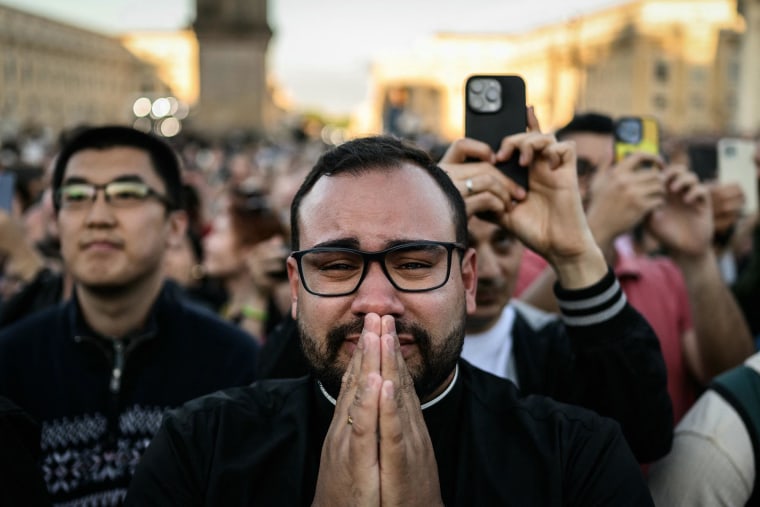
Pope Leo XIV's remarks received an emotional response from the crowd in St. Peter's Square as he made his first appearance on the basilica's main balcony.
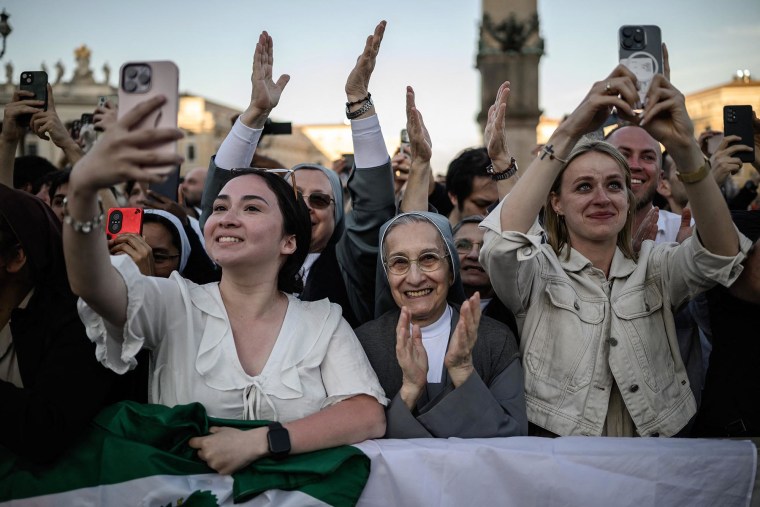
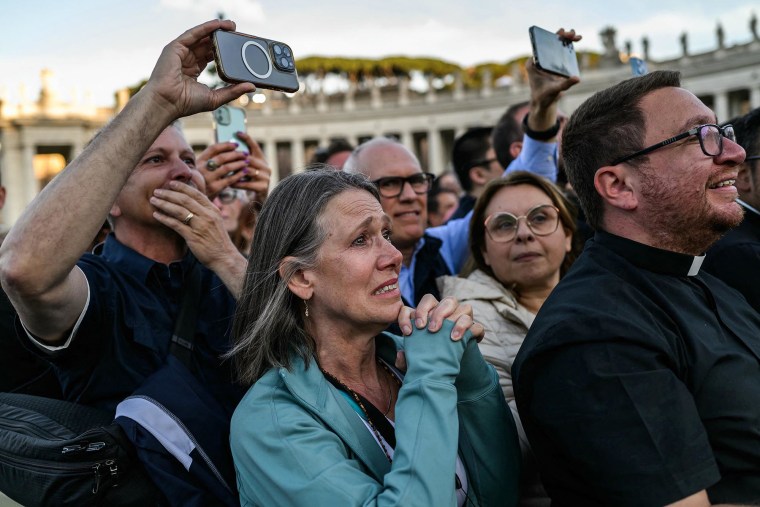
New pope spent much of his life in Peru
Born Robert Francis Prevost in Chicago on Sept. 14, 1955, Pope Leo XIV spent much of his life in Peru first as a missionary and then as an archbishop.
He started his religious journey at age 22, at the novitiate of the Order of Saint Augustine in Saint Louis, where candidates often spend one or two years preparing to enter an order founded by the 13th century saint. Later, he was twice elected prior general, or top leader, of the Augustinians.
After his time in St. Louis, Prevost went on to study at the Pontifical Saint Thomas Aquinas University, before he was ordained in June 1982.
Two years later, he was sent to Peru where he spent much of his ministry, serving in various roles. Pope Francis made him the archbishop of Chiclayo, and he became a citizen of Peru in 2015.
Francis brought him to Rome in 2023 to assume the presidency of the Pontifical Commission for Latin America.
At the same time he was appointed as the prefect of the Dicastery for Bishops, the powerful head of the office that vets bishop nominations and one of the most important jobs in the Catholic Church.
During his time in that role he presided over one of Francis' most revolutionary reforms when he added three women to the voting bloc that decides which bishop nominations to forward to the pontiff.
Pope Leo XIV is American, but isn't often thought of as one, analyst says
“He’s an American, and that in and of itself is shocking for many people who never thought that this would be possible," Christopher White, a Vatican analyst for NBC News said.
The general thinking has long been America already has too much power in the world, and should not have the papacy. "But I think someone like Prevost, who spent a third of his life in Peru and a third in Italy, isn’t typically thought of as an American by his brother cardinals," he said.
Among the cardinals, Prevost was seen as someone who "knows the Vatican, who knows the world," White said. "I think that’s what probably gave him a lot of support in this conclave because he spent so much time outside of the United States and around the world.”
Shock and excitement from a boisterous group of American priests
Reporting from Vatican City
When the new pope’s name first echoed across the square, the first reaction for many was confusion.
“Who did they say?” one person asked over the muttering. “Did he say Cardinal Robert Sarah?”
But soon that gave way to outright exultation, especially for a group of young, boisterous, American priests, who began jumping up and down and chanting, “USA! USA! USA!”
None of them had expected this result.
“I am shocked,” said Joe Brodeur, 27, a deacon from Providence, Rhode Island. “I am feeling so much joy, particularly because I love Leo the Great,” he added, referring to Pope Leo I from the 5th century.
New pope's social media already under scrutiny
Yes, the pope appears to have an X account. And it's already the subject of political scrutiny.
Pope Leo XIV's account includes a wide variety of posts, much of it relatively standard Catholic fare. But he has, at times, edged into politics.
In February, he shared a post from the media outlet National Catholic Reporter, repeating the headline: "JD Vance is wrong: Jesus doesn’t ask us to rank our love for others," in which a writer rebuts the vice president's claim in a Fox News interview that Christians prioritize loving people close to them before those from other countries.
And the pope's most recent post is actually a repost in which a Catholic commentator calls out President Donald Trump and Salvadoran President Nayib Bukele for laughing about the expulsion of Kilmar Abrego Garcia. It links to an article in the media outlet Catholic Standard, in which Bishop Evelio Menjivar asks of Catholics regarding Abrego Garcia: "Is your conscience not disturbed? How can you stay quiet?"
Some conservative commentators have already seized on the posts. Laura Loomer, a far-right commentator who has been influential with Trump, published a series of posts decrying Leo's politics. "Just another Marxist puppet in the Vatican," she wrote.
American pope may overcome 'hatred and fear that rule our nation,' faithfuls say
Reporting from Vatican City
Jenna Brown, a 19-year-old student, says her faith is so strong that she wants to become a nun. She came to the Vatican with from Seattle with her older sister Leila, 23.
“It’s a sign from God to be here on a day like this. We arrived on May 5th, but we bought the tickets in March—the day after our father died,” says Leila.
Both sisters are deeply moved that the future pope is American, even though they didn’t expect it. “The United States is a predominantly Protestant country, but we hope that with this pope, we can overcome the mutual hatred and fear that rule our nation.”
Photos: Pope Leo XIV addresses the crowd

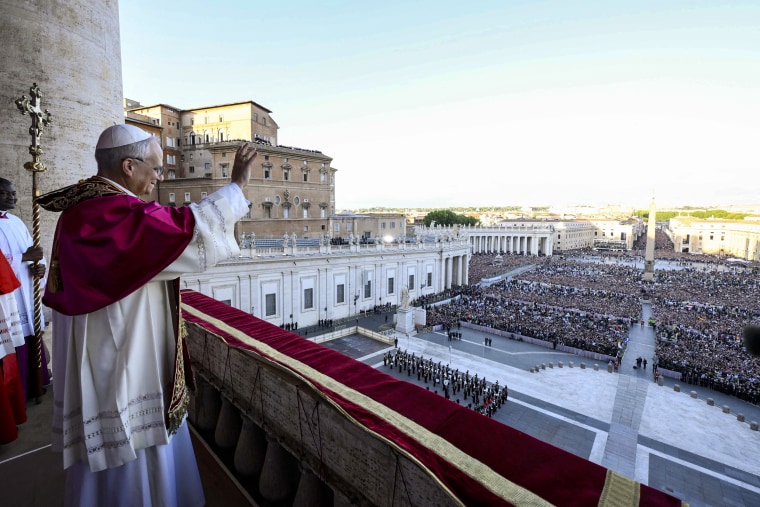
Newly elected Pope Leo XIV, formerly Cardinal Robert Francis Prevost, addressing the crowd for the first time from the central loggia balcony of St. Peter’s Basilica.
Trump says American pope is ‘a Great Honor for our Country’
“Congratulations to Cardinal Robert Francis Prevost, who was just named Pope. It is such an honor to realize that he is the first American Pope,” President Donald Trump wrote on his Truth Social.
“What excitement, and what a Great Honor for our Country. I look forward to meeting Pope Leo XIV. It will be a very meaningful moment!”
New pope is 'wonderful, gentle, profound man of God'
The new pope is as a “wonderful, gentle, profound man of God,” according to the archbishop of Philadelphia, Nelson Jesus Pérez.
Speaking to NBC News' Tom Llamas last week in Rome, Pérez said his colleague, Cardinal Robert Francis Prevost, was "a great gift to the church and the world."
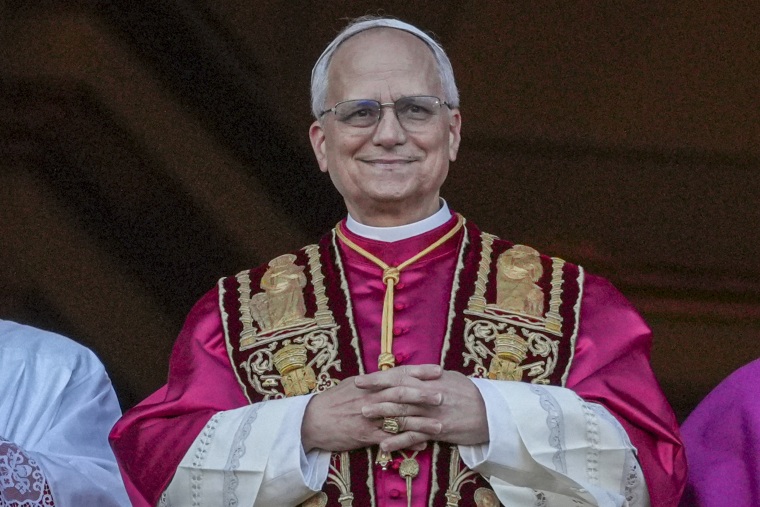
Cardinals elect American as pope
Cardinal Robert Francis Prevost is originally from Chicago and will be known as Pope Leo XIV.
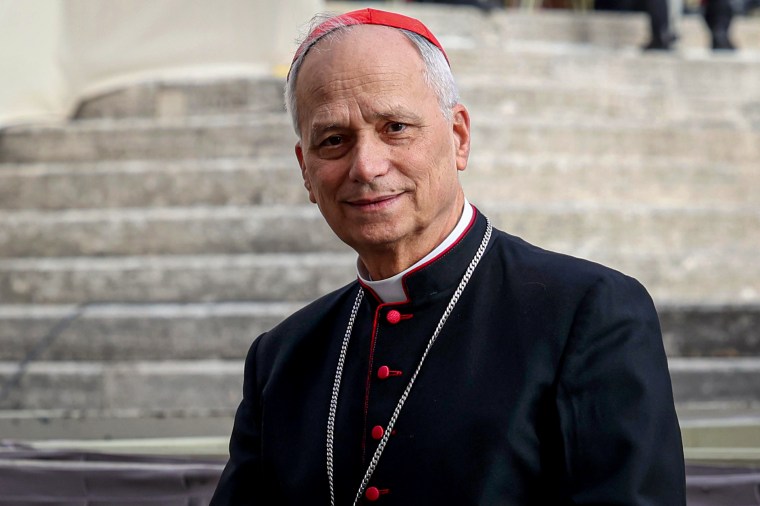
Never in the history of the Roman Catholic Church has there been an American pope.
Hope and conjecture as identity of new pope to be announced soon
Reporting from Vatican City
“I’m rooting for Pizzaballa because I just like him instinctively, even though my all-time favorite is Matteo Zuppi,” says Patrizia Giudice, 65, a retired public administration official.
This isn’t her first conclave: “From John Paul to Francis, this is my third conclave. I only missed the one when Benedict was elected because my daughter was little, and I still haven’t forgiven myself for that.”
“I just hope he won’t be a conservative—there’s really no sense in taking steps backward in 2025. If the new Pope turns out to be the Hungarian cardinal, I’m leaving the square—I won’t even wait for him to speak.”
Crowd continues to swell as people rush to St. Peter's Square before the new pope's name is announced
Reporting from Vatican City
Via della Conciliazione, the Vatican's main avenue, is full of people running to the St. Peter Square to see the new pope.
Roberta Meloni, 47, is shouting “Habemus Papam” while holding her daughter’s hand. They have been at the square since morning.
“We loved Francis, and we expect a young Pope who can engage young people. We expected so few votes because the Church needs a new pontiff, as the absence of Francis was deeply felt,” Meloni said.
New York couple 'wanted to be here for this monumental moment'
On hearing the news that the new pope had been chosen Nicole and Ryan, a couple from New York, immediately came down to Saint Peter’s Square.
“We knew we wanted to be here for this monumental moment,” Nicole told NBC News' Molly Hunter. “We were here on chance, so we had to make it down here.”
Ryan added it all seemed so “surreal,” but it reminded him of Times Square on New Year’s.
“I’ve never seen anything like this before. It’s just truly amazing. … To see the white smoke now, it’s amazing,” he said. “The amount of people that come here from all sorts of different countries to just see this amazing moment. It’s truly surreal. You see all the flags, it’s really a beautiful moment,” he added.
‘We’ve got it!’: Vatican crowd reacts to white smoke signaling new pope
'Habemus Papam!' The declaration of a new pope, translated
The world will learn who has been elected pope when Cardinal Dominique Mamberti announces his name from the balcony of St. Peter's Basilica.
He identifies the new pope by his given name, with his first name translated into its Latin version, and then announces the pontiff's newly chosen papal name.
According to tradition, Cardinal Mamberti says in Latin:
"Annuntio vobis gaudium magnum" — I announce to you news of great joy.
"Habemus Papam!" — We have a pope!
"Eminentissimum ac Reverendissimum Dominum (first name) Sanctae Romanae Ecclesia Cardinalem (surname)" — He is the most eminent and reverend Lord Cardinal of the Holy Roman Church (name).
"Qui sibi nomen imposuit (papal name)." — who has taken the name ...
In recent conclaves, the balcony appearance of the new pope has followed shortly after the "Habemus Papam."
Celebrations erupt on St. Peter's Square
Reporting from Vatican City
The are more waves of excitement from the crowds at St. Peter's Square, as the band and rows of harlequin-suited Swiss Guards arrive.
The white smoke has prompted far more flags, too: South Korean, Indian, Lebanese, Polish and Romanian.
Far from solemn, the atmosphere has turned into a party of thousands.
It’s quite hard to hear the band’s music but few seem to care.
People are posing for selfies — their “I was there” moment. And there’s one collared clergyman hoisted onto someone’s shoulders. He's draped in the Brazilian flag, his arms outstretched making two peace signs.
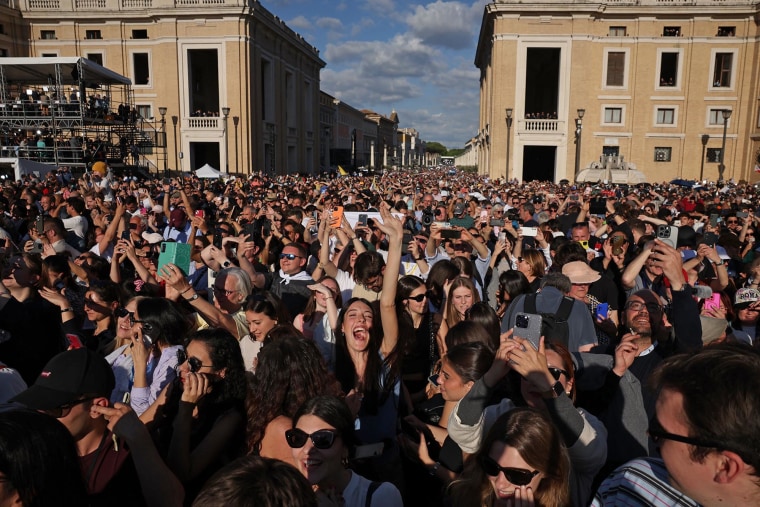
'Today we were part of history'
Reporting from Vatican City
Caroline Cooper is 70 and came from London with a friend specifically to see the conclave.
“We arrived on Monday, and both yesterday and today we’ve been here in the square all day waiting for the smoke signals.”
“We just couldn’t resist coming — today we were part of history. I’m really, really emotional,” she says, holding back tears. Her friend hands her a tissue to dry her eyes. “We hope the next pope will be as kind and generous as Francis was.”
Gathering for a view of the loggia
Reporting from Vatican City
The roof terraces of the Apostolic Palace have now filled with people, too, presumably Vatican staff who have come out to see their new leader.
What's next for the new pope
Inside the Vatican’s cloistered halls, the new pope will be preparing to adopt his papal name, which can indicate what type of pontiff he intends to be.
Then he will don a white papal cassock and the ceremonial fisherman’s ring before being led through the Hall of Benedictions and out onto the balcony, known as the Loggia of the Blessings.
There, his identity will be revealed to the thousands gathered below and the millions more around the world who have closely watched the conclave.
Crowds await reveal of the new pope
Reporting from Vatican City
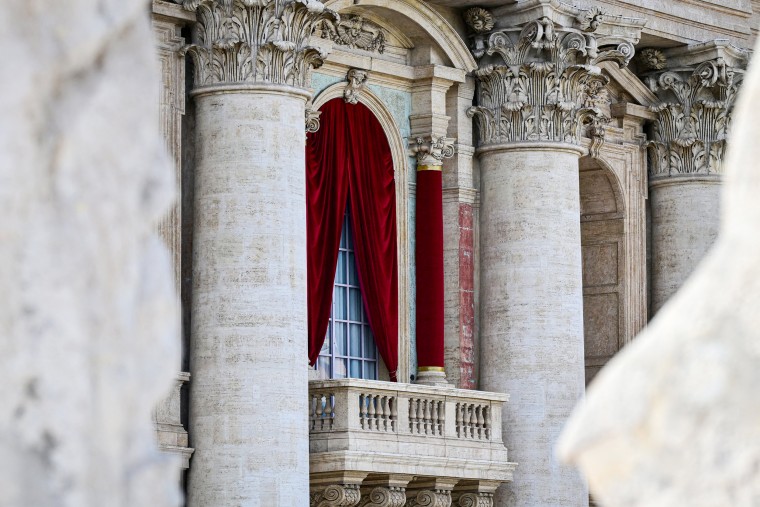
The crowd’s attention has now turned from the chimney to the loggia, the balcony where the new pope's name will be announced.
Rapturous applause greets announcement of new pope
Reporting from Vatican City
“They did it, they did it!”
Rapturous applause, yelling and plenty of tears in St. Peter’s Square at the sign of white smoke.
“I’m so happy, it’s so incredible to be here at this moment,” said Roseleia Cordeiro, 42, from Brazil, weeping while embracing a group of friends. “I don’t know how to express myself but I am grateful to God for this moment.”
The smoke came and came — and kept coming — each renewed billow prompting a fresh wave of emotion from the assembled masses.
White smoke and a new pope
Reporting from Vatican City
Habemus Papam! White smoke billowed from the Sistine Chapel's chimney this afternoon, announcing the election of a new leader for the world’s 1.4 billion Catholics.
Crowds in St. Peter’s Square erupted in cheers as bells pealed from the towering basilica, confirming that the 133 cardinal electors who have been sequestered inside since Wednesday had reached a two-thirds majority decision on who will succeed Pope Francis.
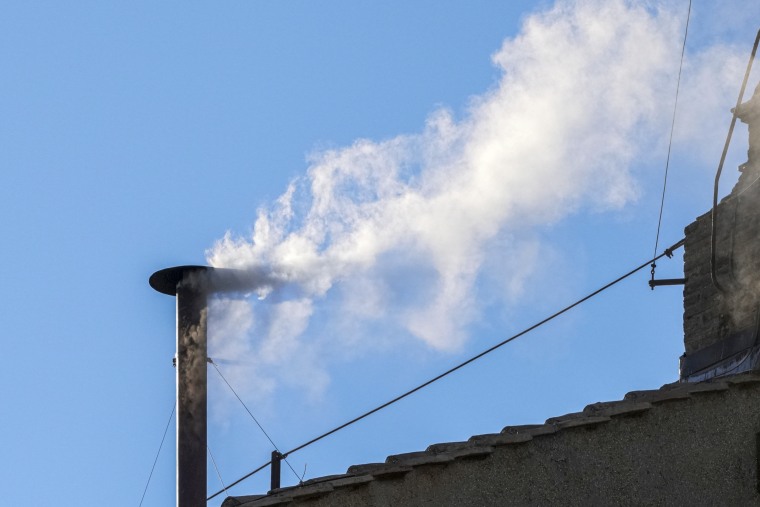
The new pope’s identity will be revealed shortly by Dominique Mamberti, the senior cardinal deacon, who convention says will appear on the St. Peter’s balcony that overlooks the square and announce, “Habemus Papam” — “We have a pope.”
Inside the Vatican’s cloistered halls, the new pontiff will be preparing to adopt his papal name — which can indicate what kind of pope he intends to be — before donning a freshly tailored white papal cassock and the ceremonial fisherman’s ring.
He will then be led through the Hall of Benedictions and out onto the balcony, known as the Loggia of the Blessings, where his identity will be revealed to the thousands gathered below and the millions more around the world who have closely watched the conclave.
Two votes, one smoke expected for this afternoon
According to general guidance issued by the Vatican, the third vote should currently be underway, beginning at around 5:30 p.m. local time (11:30 a.m. ET). A fourth is scheduled for 7 p.m. local time (1 p.m. ET). In the past, it has taken at least an hour and possibly more for each vote to conclude, and the Vatican's guidance is subject to change.
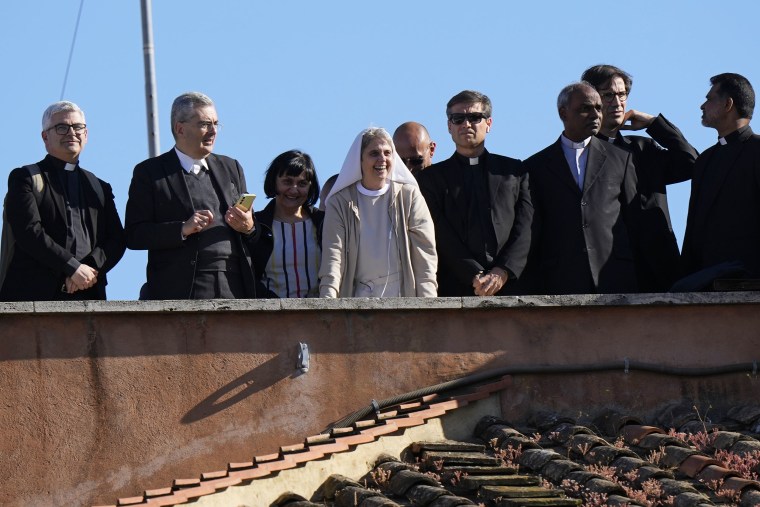
Typically, there is no smoke for each of the four votes. Black smoke billows after a pair of inconclusive votes, while white smoke will immediately billow if a new pontiff is chosen.
Hoping for a pope who understands the lives of Catholics outside Europe
Reporting from Vatican City
A challenge for the next pope — wherever he is from — will be how to address the needs of a church whose flock is growing fastest in the Global South.
“We need a pope who understands the issues facing the Third World,” said Piere Domerson, 39, a priest from Haiti currently studying in Rome. “We always remember how Pope Francis understood this universality of the church,” he said, as he waited for the smoke in the warm afternoon sun. “And because he appointed more cardinals from outside Europe, we have seen that become more universal, too.”
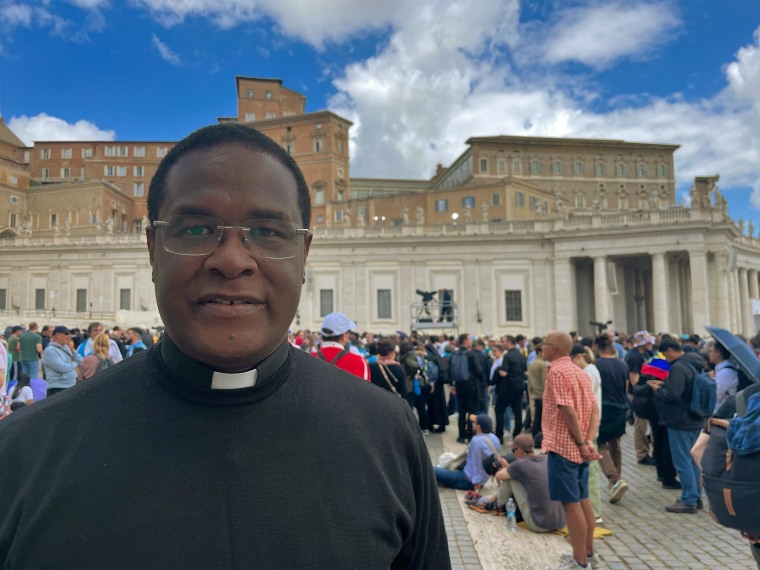
World flags are flying as global Catholics converge on St. Peter's Square
Reporting from Vatican City
Almost like a music festival, some people have brought flags on long poles that flutter high above the crowd.
Among them are the Bulgarian, Spanish, Czech and Brazilian emblems. And Jerry Grogan, from Indianapolis, is waving the Star Spangled Banner.
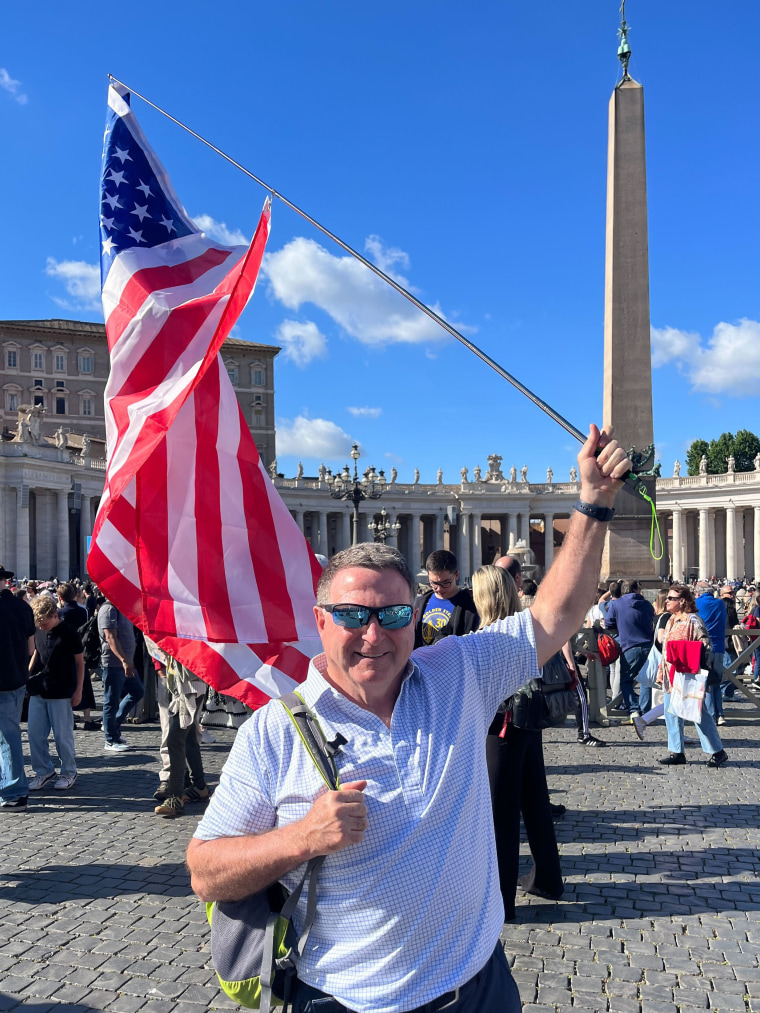
“I think there’s a strong possibility they may reach a decision this evening and elect the next pope,” said Grogan, 65, who works as a construction manager.
Another American, Brendan Prestage, 24, from Boston agrees.
“The probability based on previous conclaves is that it could be this evening,” said Prestage, who works in tech and said prayer helped him when he was recently fired from one of the industry giants. “I hope it’s this evening because I have to fly home tomorrow for a friend’s wedding.”
The conclave is an election like no other
The conclave is unlike any other election, and not just because of its sacred or spiritual dimension.
Officially, there is no open campaigning or polling, and in this election, hardly any indication about whether there are any leading contenders for the next pope. The candidates do not declare themselves publicly, nor do the cardinal-electors speak on the record about who they might vote for.
The voting results are not made public, either. A conclave has often been referred to as one of the few occasions where it is hard to predict the internal dynamics, especially given the diverse and larger-than-ever nature of this group of cardinals.

Air of anticipation as people line up for smoke watch at St. Peter's Square
Reporting from Vatican City
The security line outside the square is far busier than it was yesterday.
There is an air of anticipation, a chance this could be the one, with the cardinals inside taking their fourth and fifth votes since this process began.
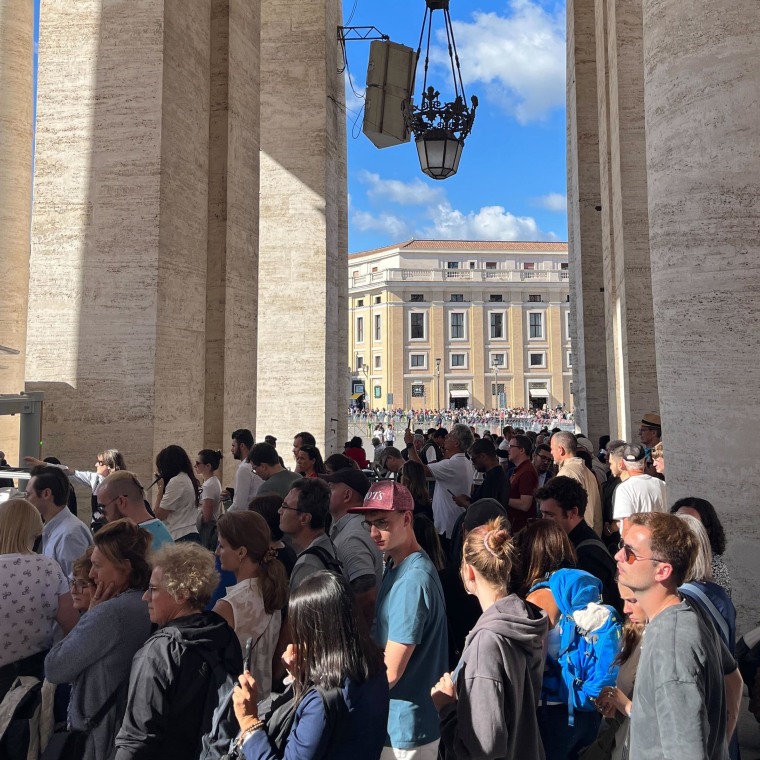
Begrudged restaurant worker says phone signal outage more 'a matter of principle'
Reporting from Vatican City
Anna Rita Cherubini, 52, was born and raised in Rome, and for the past 10 years has worked at Angelo alla Cupola, a restaurant just a street away from the Vatican. “Work-wise, this internet shutdown hasn’t hit us too hard — sure, the POS system is a bit slower, but it still works," Cherubini said.
But, she added, "It’s more a matter of principle."
"Do regular people who are just working or living their lives really have to pay the price because some cardinals aren’t responsible enough to stay off their phones when it’s forbidden?” she said.
Smoke watch begins again
The cardinal electors are believed to have returned to the Sistine Chapel to vote in the fourth ballot, after two votes this morning lasted around three hours.
Smoke could come sooner, or as we saw yesterday, later, after the second vote takes place this evening at about 7 p.m. local time (1 p.m. ET).
Politically savvy cardinals will want to quickly wrap up this conclave, historian says
This year’s conclave is the largest ever, with 108 of 133 cardinal electors having never before taken part in the election of a new pontiff. It’s also the first time that cardinals from outside Europe — more than 20 are from Asia and 18 are from Africa — outnumber their European counterparts.
While many of those voting for the first time were chosen by the late Pope Francis and may look to continue his progressive legacy, conclaves are ultimately “hard to predict because they’re completely secretive,” said Miles Pattenden, a Catholic Church historian from Oxford University.
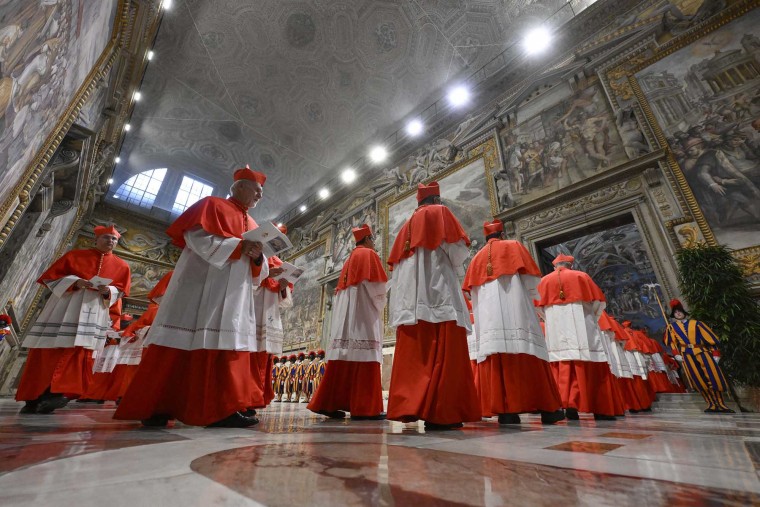
This conclave's 133 cardinal-electors are “sophisticated electorates of very experienced men, most of whom got to be cardinals because they’re good at politics.” But these men also know better than to openly vie for the role: “The first rule if you want to be pope is never to campaign to be pope,” he said.
Still, the historian, who is watching the events unfold in Rome, said he wouldn’t be surprised if a new pope was elected this afternoon, given that the last two papal elections, in 2005 and 2013, also ended on the second afternoon.
“That’s the best narrative for them,” Pattenden said, adding that failing to reach a decision by Friday would most likely result in a “more intensive” phase of voting on Sunday, with a rest day on Saturday. He warns that the delays could also signal to those watching that the divisions in the Church "are actually bigger than they’ve been letting on.”
But he said the cardinals may have already narrowed their choice down to three or four in the first three rounds of voting, “so they’ll have a good idea of who’s viable and has momentum,” he said.
Still, he hedged his bets by adding, “obviously, we have no access whatsoever to any of that information.”
What do cardinal electors eat during the conclave?
You may think the red-robed voters will be enjoying a conclave feast. But they’re not.
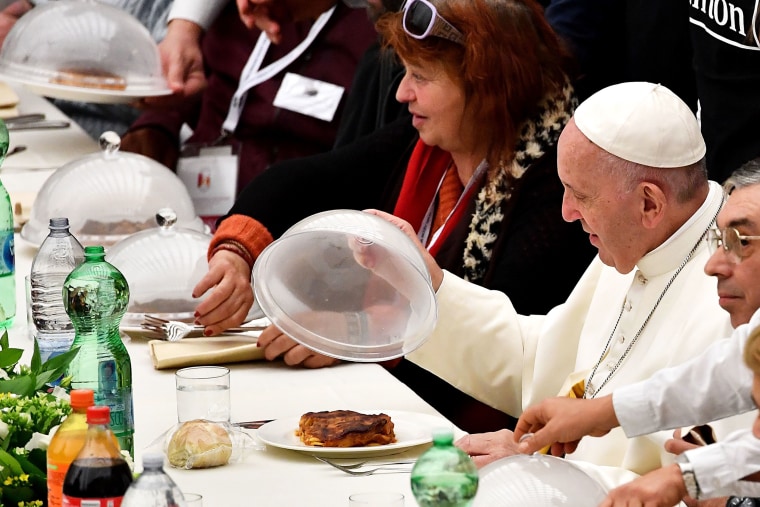
The conclave menu is simple, offering only basic food, including pasta, white meat or fish, vegetables, as well as bread and fruit, according to the National Catholic reporter. Desserts are served only on rare occasions.
No voter can dine out since the conclave is secluded from the outside world.
Food is delivered through a revolving door after a careful inspection to prevent secret messages, with pies and chicken forbidden as it would be too easy to stick a note inside, according to an account by a papal personal chef in the 16th century.
Tight control over food in the conclave started in 1274 when Pope Gregory X decreed that cardinal electors would get only one meal a day if the papal voting took longer than three days. The restrictions were imposed to ensure a more efficient voting process, although they have since been relaxed.
A traditional conclave calls for a traditional lunch for smoke-watchers
Reporting from Vatican City
A lunch break for the conclave-watchers. After midday when the black smoke wafted, thousands spilled out of the square and across the River Tiber like pilgrims following Constantine the Great.
The five-hour break was a perfect chance for worshippers and tourists alike to sample Rome’s legendary gastronomic scene.
People sipped chianti in sun-dappled trattorias on Via dei Banchi Vecchi, and swooned over burrata alongside the Venetian-red stucco walls of the city's historic buildings.
Alessandro Masseroni, 25, a deacon from the north of Italy studying to be a priest in Rome, almost scoffed when NBC News asked what he ate.
“Carbonara, of course!” he said.
Americans may think they have eaten this classic dish, but their inclusion of ingredients such as ham and cream appalls people in the Old Country, where eggs, pecorino romano and pork jowl are the only accepted ingredients.
“It was fantastic,” Masseroni says by way of review, before making his way back to the square.
Lines of onlookers at St. Peter's Square
Reporting from Vatican City
The electors are all on their lunch break right now, so there’s no chance of new smoke until they get back to voting at the Sistine Chapel. But that’s not stopping people from trying to get into the square. At the north gates, crowds are lining up to have their bags checked before they enter.
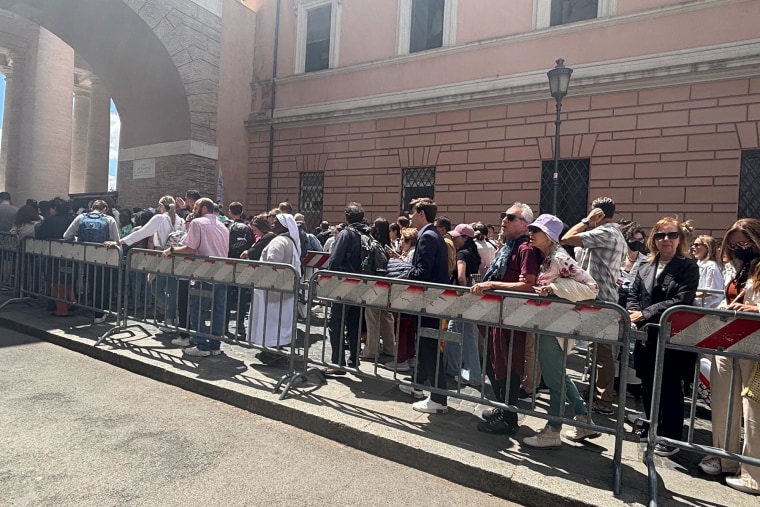
For cafe owners, the Vatican's signal blackout is causing a lot of problems
Reporting from Vatican City
Cardinals may be facing a lock-in and a telecommunications blackout as they vote for Pope Francis' successor, but the patrons of the Gran Caffè Rossetti hadn't bargained for the same.
It’s the only café that faces Piazza Papa Pio XII, so you’d expect it to be full of customers. But not even half the tables are occupied. “The area isn’t freely accessible, and a lot of people are struggling to get here,” says Flor Venegas, 46, originally from Venezuela and now the café’s manager.
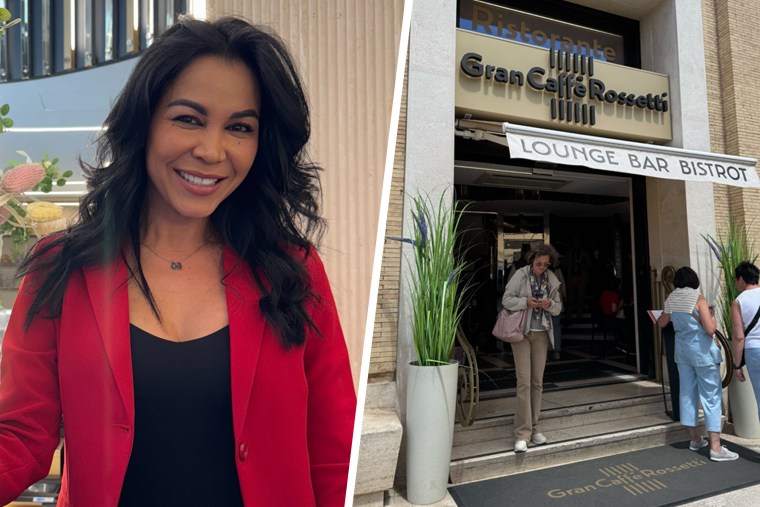
During the late pope's funeral and now the conclave, Venegas said the cafe has lost a lot of its customers because the area has been secured.
Plus, a partial outage affecting some network repeaters is causing more problems: the card reader only works intermittently, and that leads to endless lines of frustrated customers. “No one told us anything about these possible issues with the phone network — it’s honestly absurd,” Venegas said, visibly frustrated.
She adds, “We just hope this conclave ends soon, because it’s simply impossible to work under these conditions.”
People turned to this Oscar-winning film to find out how a papal conclave works
As the Vatican prepared for the election of a new pope, many around the world were doing their own preparations — by watching a movie about it.
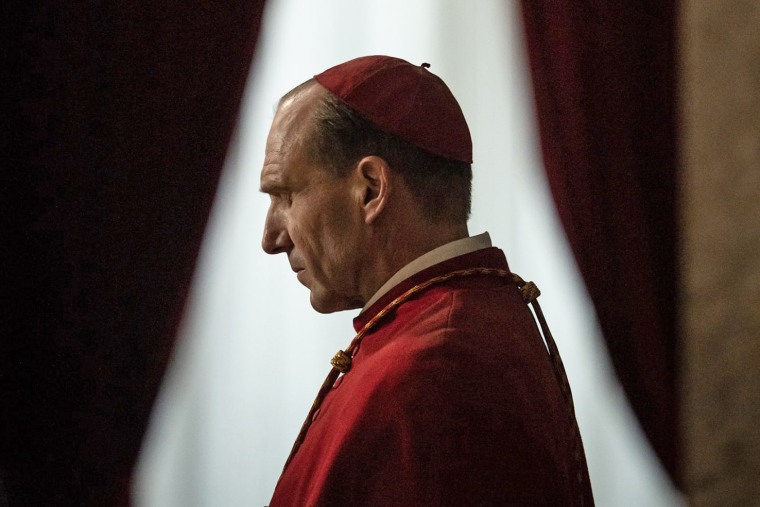
After news of Pope Francis’ death broke, the film “Conclave” had a viewership boost across streaming platforms it was available to watch on, according to Luminate, an entertainment data analytics company.
Edward Berger’s drama, which won the Oscar this year for best adapted screenplay, goes behind the scenes of the Vatican for the secretive process of electing a pope. The process is complicated further by power-hungry cardinals, played by Ralph Fiennes, Stanley Tucci and John Lithgow. (The film’s distributor is Focus Features, a unit of NBC News’ parent corporation, Comcast.)
Since its release in October, the movie has spawned a fervent fan base online, with many social media users circulating a slew of viral memes and passionate fan edits comparing it to pop culture staples like “The Real Housewives” and “Mean Girls.”
How much longer will it take to elect a new pope?
If you're just joining us, it’s day two of the conclave and if history is any guide, it may not be too much longer before we have a new pope. Here's a look at the last few conclaves and how long they took to come to a decision:
- In 2013, Pope Francis was elected after five ballots over two days.
- In 2005, Pope Benedict XVI was elected after four votes in two days.
- In 1978, Pope John Paul II was elected after eight ballots and three days.
In fact, there hasn’t been a conclave that lasted for more than four days since Pope Pius XI was elected in 1922 after five days.
Let's see how today's second set of votes pans out.
St Peter’s Square crowds react to black smoke
A few minutes ago, black smoke billowed from the Sistine Chapel chimney signaling that a decision had not yet been made on who will be elected the new pope.
Here are some of the scenes from the crowds in St. Peter's Square as news broke:
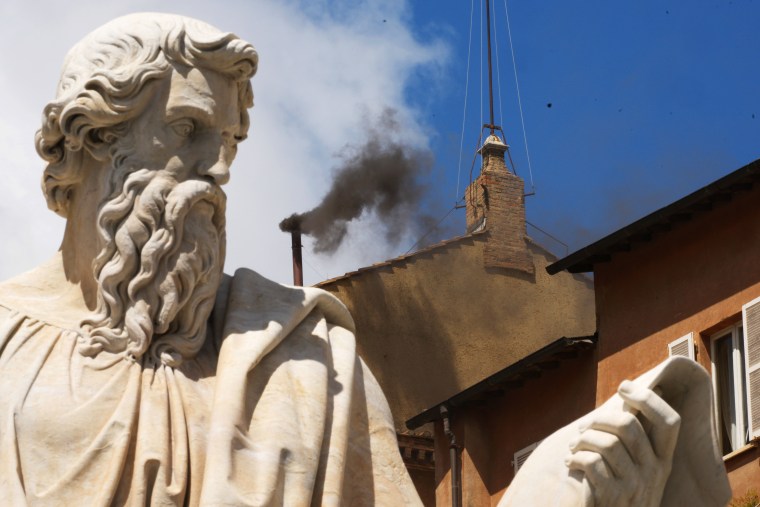
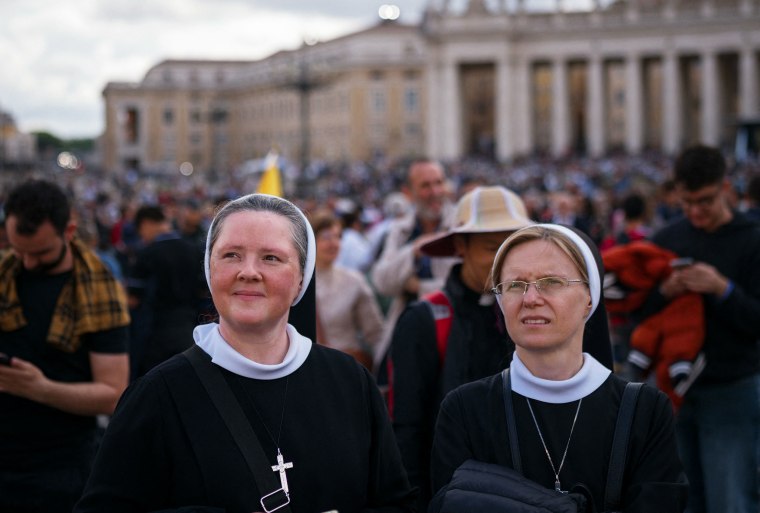
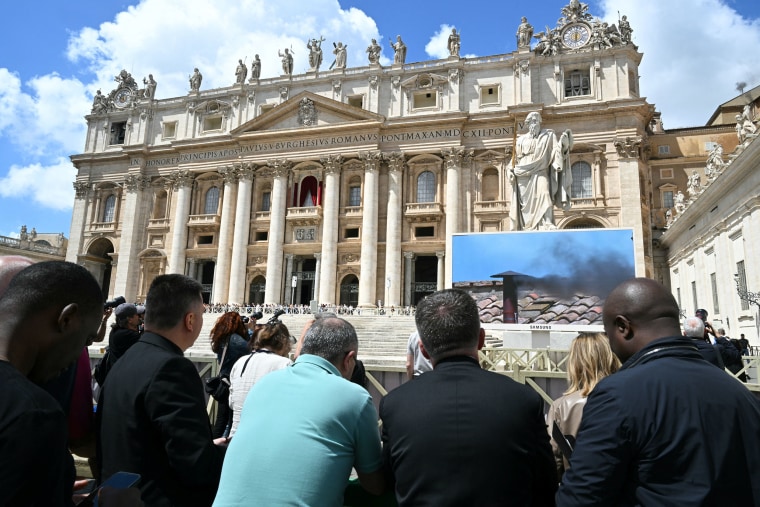

Everything you always wanted to know about conclave voting but were too afraid to ask
Voting in the conclave is a highly choreographed and highly scrutinized process that involves non-electing cardinals — usually churchmen over the age of 80 who are barred from voting — taking on different roles.
Nine ballot-officials chosen by the junior cardinal-deacon help keep the ballot process fair and running smoothly. They include three scrutineers, who announce and count the votes; the revisers, who check the work of the scrutineers; and 3 infirmarii, who collect ballots from any cardinal too unwell to make it from their lodgings to the Sistine Chapel for the vote.
When it's time to vote, the masters of ceremonies and the secretary of the College of Cardinals must leave the cardinal-electors alone in the Sistine Chapel. The cardinals then proceed to the altar and hold their ballots aloft beneath Michelangelo’s "Last Judgment" so that they can be seen by all present.
Each cardinal kneels for a moment of prayer, before rising and saying, “I call as my witness Christ the Lord, who will be my judge, that my vote is given to the one who before God I think should be elected.” He then puts his ballot onto the paten, or small plate, from which it is tipped into a receptacle shaped like a large chalice. The cardinal then returns to his seat.
With all votes cast, the scrutineers make sure that the right number of ballots is present, before giving the urn a shake and transferring the ballots one by one to another urn. If the number of ballots is off, all votes are immediately invalidated and burned, followed by another vote. If the count tallies, the ballots are then opened and counted.
Seated at a table before the altar, scrutineer 1 opens a ballot, notes the name, and passes it on to scrutineer 2. He also notes the name, before passing the ballot to scrutineer 3, who reads out the name and marks his own “scorecard.” Cardinals are allowed to keep their own tally, too, but they have to be burned with the ballots at the end of each voting session.
After reading out each ballot, the scrutineers thread the ballots together, knotting the tally at the end of counting. After the final ballots are opened, the scrutineers tally the votes and write them on a separate sheet of paper.
10,000 spectators watched the black smoke this morning
Reporting from Vatican City
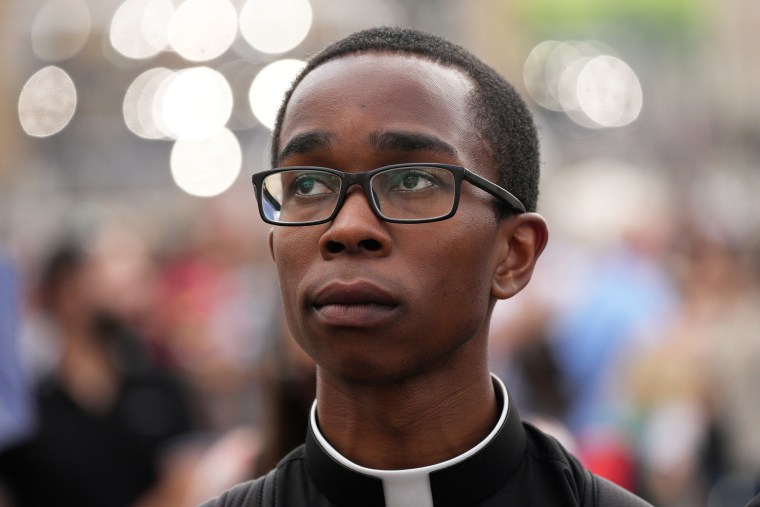
Rome police tell NBC News that around 10,000 spectators were gathered in St. Peter's Square to watch the black smoke coming out of the Sistine Chapel chimney.
Black smoke billows as Catholic cardinals remain undecided on new pope
Reporting from Vatican City
The cardinals will now break for lunch
With second round of voting this morning now complete, the cardinals will soon break for lunch, leaving the Sistine Chapel to return to their lodgings at Casa Santa Marta.
Then they will return to the chapel for another two rounds of voting later this afternoon, scheduled to begin around 4 p.m. local time (10 a.m. ET).
Smoke-watchers will just have to come back later
Reporting from Vatican City
For a few seconds it wasn’t entirely clear what color the smoke was. When it billowed into the blue cloud-dappled sky, it certainly looked a little gray.
“For a moment, I thought — it’s white, it’s white!” said Miguel Alfonso, 35, a priest from Honduras.
Before long the result was unequivocal, however.
“Ah, negra!” his friend, David Barrios, 41, a priest from Valencia, Spain, shouted.
Shortly before that, confusion and excitement abounded as the smoke turned white for just a second before it went out. It's safe to assume this was just the chemical element of the stove being turned off.
Black starts to emanate from the Sistine Chapel chimney
Plumes of black smoke were seen billowing from the Sistine Chapel chimney, signaling that the 133 cardinal-electors have not yet reached a decision to elect a new pope.
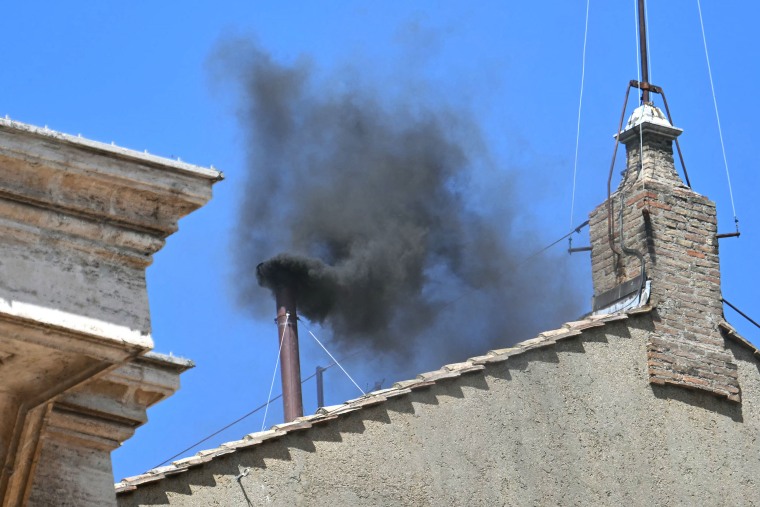
The cardinals must come to a two-thirds majority to reach a decision. It's the second black smoke signal of the conclave after three rounds of voting.
At age 45, Ukrainian-born cardinal is youngest papal elector
The average age of cardinal voters is 70 years and three months. But the conclave’s youngest member is only 45.
Born in Ukraine in 1980, Mykola Bychok is a Melbourne-based bishop. Bychok became the most senior Catholic official in Australia when he as “elevated to the dignity of Cardinal” last year by late Pope Francis.
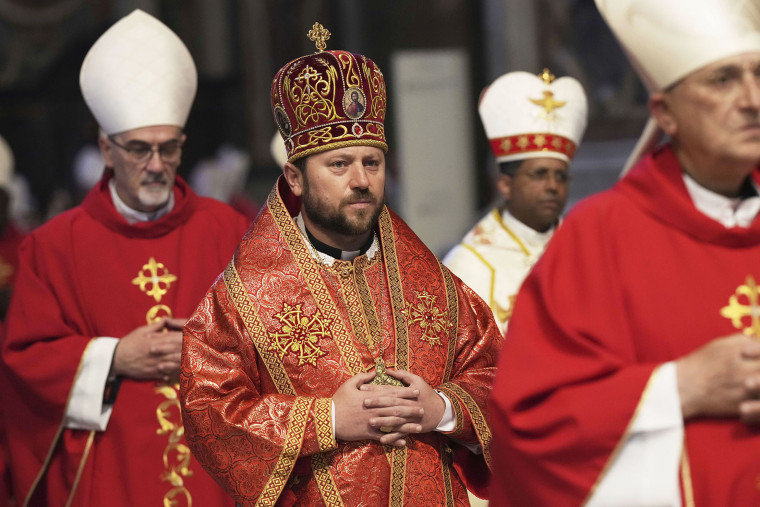
He is the first Australia-based cardinal since George Pell, who died in 2023. Bychok spent most of his priesthood in Ukraine and served as a vicar in New Jersey from 2015 to 2020.
Bychok has been based in Melbourne since January 2020 and will be eligible to apply for Australian citizenship this year, according to the Australian Broadcasting Corporation. He was enthroned in 2021 as the third bishop of the Melbourne Eparchy.
No smoke so far means no decision just yet
There has so far been no smoke from the Sistine Chapel's chimney, which means that the cardinal-electors have not yet reached a conclusion on who should be the next pope.
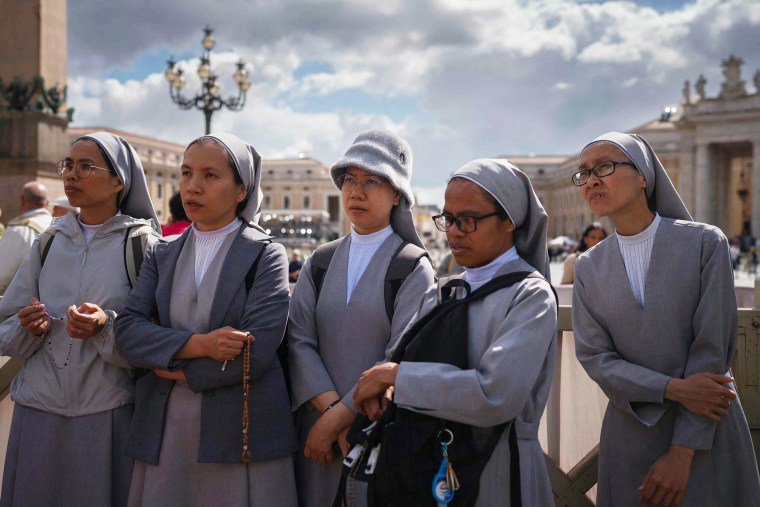
It could also mean that the first morning vote has gone over time. If we don't see smoke soon, we may next expect it at around noon local time (6:00 a.m. ET). As a reminder: there are four chances for white smoke on a regular conclave day — after each of the four votes — but only two chances for black smoke after each pair of votes.
Last night, crowds waited much longer than expected for a smoke after after Wednesday’s first ballot.
There was speculation around why it took so long: it could be that the meditation ahead of the vote ran much longer than anticipated, or that the voting was delayed because of a procedural mistake. It may also have something to do with the fact that there are more cardinals than ever before, most of whom are new to conclaves, and therefore took more time than estimated to vote.
Argentinian family talks of worship — and soccer — outside the Apostolic Palace
Reporting from Vatican City
In the throng outside the Apostolic Palace you will find conversations about religion, politics, local gastronomy — and soccer.
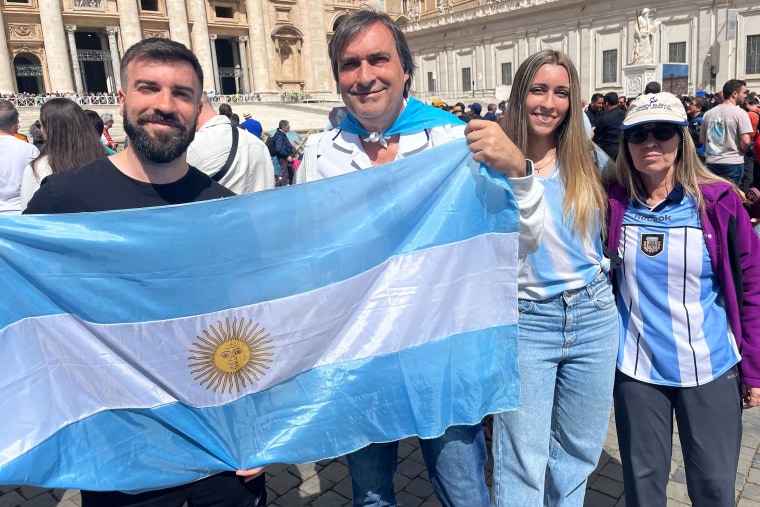
The Borggiano family are from Buenos Aires, near the neighborhood where the late Pope Francis grew up. They flew here to see the conclave — but right now they are debating which Argentinian legend is better: Lionel Messi or Maradona.
“You’re British?” Ricardo Borggiano, 62, correctly says of this NBC News reporter. “What do you think about Maradona?” he asks cheekily, gesturing with his outstretched arm in a reference to the “hand of god” goal that saw Argentina eliminate England from the 1986 World Cup.
After NBC News attempted to get the conversation back to the matter in hand, his son, Frederico, 33, who now lives in Madrid and met the rest of the family here, said, “We’ve just had an Argentinian pope, so I don’t think we’ll get another one. I just hope we see white smoke today.”
Holy smokes! Everyone’s watching for black or white smoke, but how is it made?
All eyes are on the Sistine Chapel chimney to see if the cardinals have elected a new pope, signified by whether it will billow a white smoke and the church bells ring.
With two morning votes and two afternoon votes on each full day of the conclave, the temporary chimney installed last week by the Vatican’s fire department will emit black smoke if the vote is inconclusive.
It may seem as old as the papacy itself, but the frescoed chapel’s cast-iron stove was first used in 1939 to burn ballots and personal notes. Since 2005, the use of that stove triggers an electronic, smoke-producing device outfitted on a second, more modern one. Both stoves are about 3.2 feet high and have two openings — one for lighting them and one for ballots.
According to the Vatican press office, the black smoke is made by a cartridge holding a mixture of potassium perchlorate, anthracene and sulphur. The white smoke is created by a mixture of potassium chlorate, lactose and a pine resin also known as Greek pitch. The smoke travels up almost 100 feet of steel and copper tubes to the chimney and the world beyond.
Panini, water and a telescopic folding stool: how to survive the conclave
Reporting from Vatican City
For the avid smokewatcher, preparation is key.
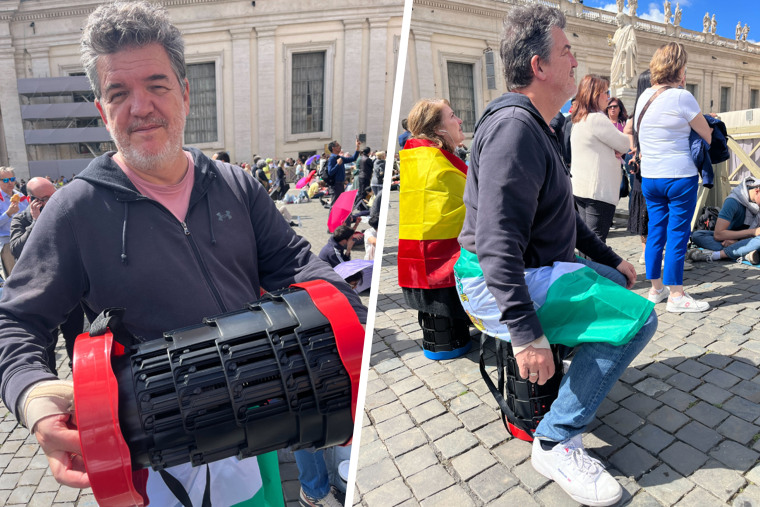
In this sense, it’s clearly not Joaquin Lopez’s first rodeo. The Spanish telecoms engineer is used to lengthy religious gatherings, having waited for six hours at Semana Santa — Spain’s Holy Week — last month.
Down at the very front of St. Peter’s Square, he proudly shows off his top conclave hack: a folding, telescopic stool. These are common in his native Spain because of municipal laws banning portable backed chairs at such events.
“We knew we would have to wait a long time and so this is perfect,” said Lopez, 55, from Andalusia, proudly shrinking down his seat to little larger than a dinner plate. “We were here for five hours yesterday but it was fine because we were able to sit down, eat some paninis and drink water. We had some beers but we weren’t allowed to bring them in, so we had to drink them at the security scanners outside.”
Crowds in St. Peter's Square eagerly await the results from the second vote
Reporting from Vatican City
There are already thousands of people in St. Peter’s Square eagerly awaiting the results from the second round of voting. If the cardinals have elected a new pope, white smoke should soon appear from the Sistine Chapel chimney around 10:30 a.m. local time (4:30 a.m. ET).
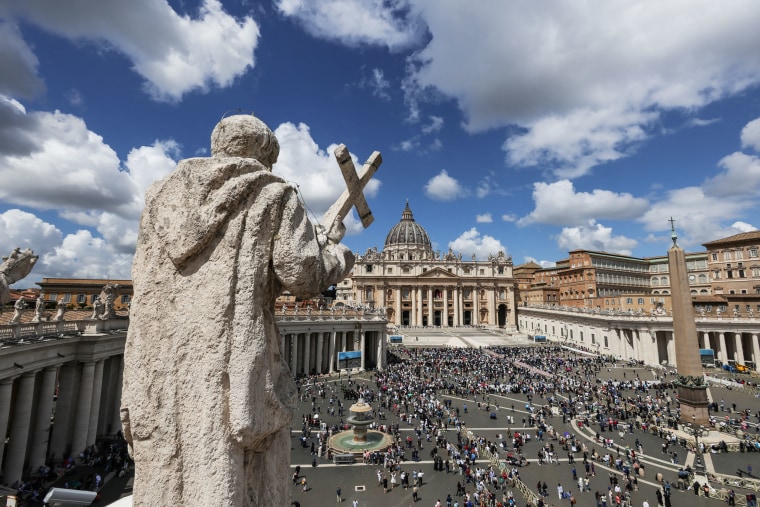
The weather is a weird mix of warm sun that keeps hiding behind a big gray cloud sprinkling the cobbles with intermittent drizzle. Groups of firefighters, police and civil guard have ducked into a cafe just off the square to stock up on coffee and cream-filled maritozzi buns.
“It’s been very, very busy,” says one of the a baristas clearing away small plates from the counter, apologizing that they don’t have time to give their name. “It looks like today will be the same.”
Even the ballot cards used by the cardinals were designed carefully
The cardinals are casting their ballots using an elaborate, highly scrutinized system which begins with the ballot cards themselves. Said to have been designed by the late Pope Paul VI, who died in 1978, the ballot cards on which each cardinal will write in the name of his preferred candidate are rectangular in shape so that they can be folded in half and read, “Eligo in summum pontificem...” or, “I elect as supreme pontiff...”.
Each cardinal will receive multiple ballots from the masters of ceremonies. After writing his preferred name, he will fold his ballot card over twice. Cardinals may only write the name of one candidate; more than one name would deem their ballot invalid.
Who will be the next pope?
Dust off the history books and there are papal conclaves with international intrigue, royal rigging and even riots, a checkered past that belies the air of sanctity and solemnity surrounding modern papal elections.
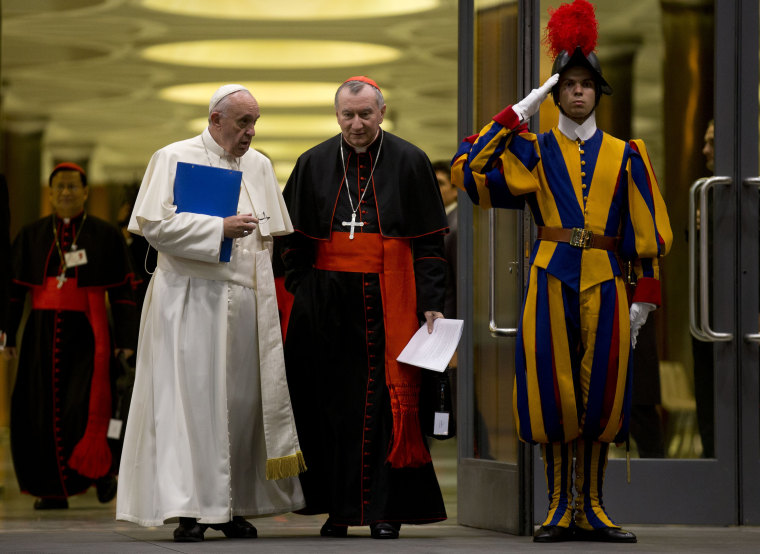
“The great joy of the conclave is that nobody really knows and it’s such a unique electorate,” James Somerville-Meikle, the former deputy director of the Catholic Union of Great Britain, told NBC News before Francis’ death. “So many conclaves in the past have thrown up surprises.”
The College of Cardinals, he said, has always been faced with two questions: “Do we try something new? Do we go for continuity?”
Take a look at NBC News' analysis of Cardinals Zuppi, Parolin, Tagle, Erdő, and the other men tipped to be the next leader of 1.4 billion Catholics around the world.
Catholic cardinals take secrecy oaths in Latin ahead of the start of conclave yesterday
What can we expect from today's schedule?
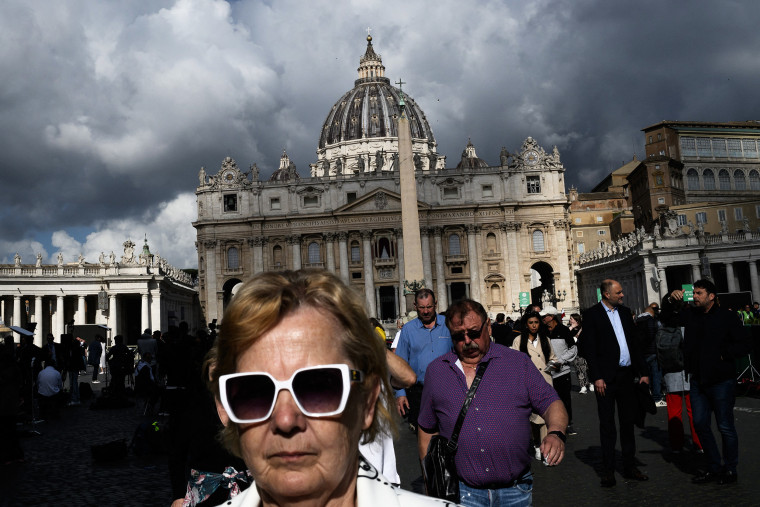
Today will see the cardinals assemble for a second day of voting to elect the new pope. They can vote up to four times a day, with two rounds taking place in the morning and two in the afternoon. Meanwhile, crowds continue to gather in St. Peter's Square and wait for a white smoke signal from the Sistine Chapel's chimney, which will indicate that the 267th pope has been chosen.
The times below are estimates based on Vatican guidance and the past two conclaves, and can vary throughout the day.
- 7:45 a.m. (1:45 a.m. ET): The cardinals will have breakfast before leaving Casa Santa Marta, the five-story guesthouse in St. Peter's Basilica where they reside in total isolation for the duration of the conclave.
- 8:15 a.m. (2:15 a.m. ET): The cardinals will attend a Mass held in the Pauline Chapel.
- 9:15 a.m. (3:15 a.m. ET): The first vote commences.
- 12:00 p.m. (6:30 a.m. ET): The second vote commences.
- The cardinals will leave the Sistine Chapel for lunch.
- 3:45 p.m. (9:45 a.m. ET): Cardinals will return to the chapel for the next round of voting.
- 5:30 p.m. (11:30 a.m. ET): The third vote commences.
- 7 p.m. (1 p.m. ET): The fourth vote commences.
- The cardinals will return to Casa Santa Marta for dinner.
There tends not to be smoke for each of the four votes. Black smoke, for example, will only follow a pair of inconclusive votes. Meanwhile, if a new pope is chosen, white smoke will immediately follow the conclusive vote regardless of whether it's the first of a pair or the second.
The first ballot round begins
If Vatican guidance is correct, by now the cardinals will have returned to the Sistine Chapel to cast their first votes to elect a new pope. It's the first of up to four rounds of voting expected to happen throughout the day.
Black smoke signals no new pope chosen on first day of conclave
The doors of the Sistine Chapel were sealed Wednesday as the papal conclave got underway. After three hours and fifteen minutes, black smoke billowed from the chimney above the chapel, signaling the cardinals had not yet selected a new pope. NBC News’ Lester Holt reports from the Vatican.
First night of voting left crowd anxious and jubilant
Reporting from Vatican City
When the black smoke finally came after more than three hours last night, for some the mood had sailed way past excitement through anticipation, and it was hovering dangerously close to distraction.
It was soles rather than souls that needed prayer, and standing with limited supplies of food and water became too much for a few of the observers. At one point, a golf cart drove through the throng and collected someone in need of medical attention. Others appeared to leave the square altogether. People kept busy by cheering the occasional seagull that landed next to the chimney or by clapping, perhaps in the hope that those hermetically sealed inside the Sistine Chapel might hear their encouragement.
The long-awaited moment diced with anticlimax. Past 9 p.m. local time, it was too dark to see the chimney against the sky, so most people had their eyes and phones trained on the big screens showing the action. But seconds before the smoke finally arrived, the screens cut out, meaning it was difficult to actually see the moment itself.
For the faithful gathered here, of course, the sideshow drama was not the point.
“I was asking my soul, ‘What’s with the long wait?’” said the Rev. Mac Bean, 27, a priest from Zimbabwe who was wearing a white flat cap and white collar tucked into his blue short-sleeve shirt. “But it’s normal not to get a decision on the first try.”
Meryl Adriano, 41, a teacher from Melbourne, Australia, said: “I don’t mind waiting, because we’re on holiday for two weeks. What’s a few hours when we’ve waited 12 years to see this? There are so many other people waiting, too, they are giving us energy.”
Day 2 of conclave starts after black smoke billows
The 133 cardinal electors will shortly return to the Sistine Chapel to commence the second day of the conclave after black smoke billowed from the chimney atop the Sistine Chapel last night.
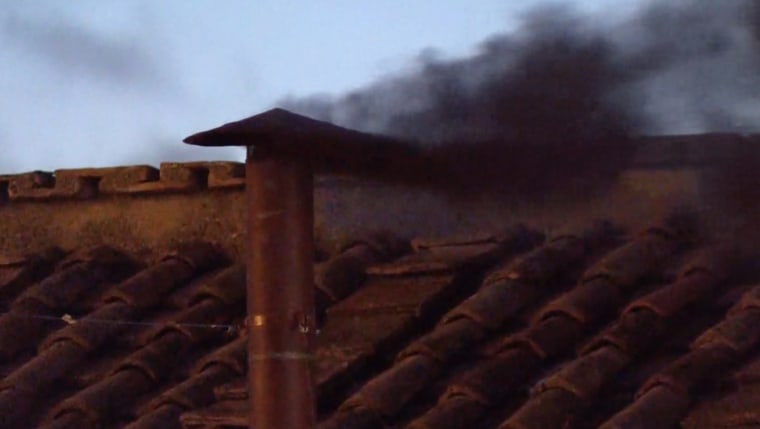
Smoke of that color indicates that no new pope was elected during yesterday’s first round of voting.
According to the Vatican's schedule, today could see the cardinals casting ballots four times.
After having breakfast, the cardinals have headed to a Mass service before returning to voting, with two ballots cast in the morning starting at 9:15 a.m. local time (3:15 a.m. ET) and two in the afternoon starting at 5:30 p.m. local time (11:30 a.m. ET).


















